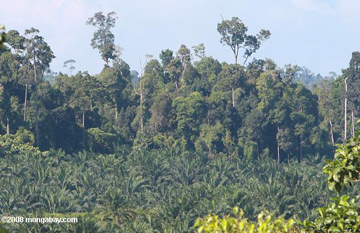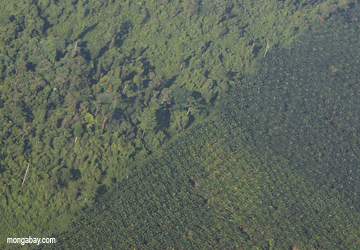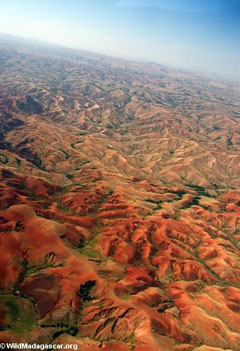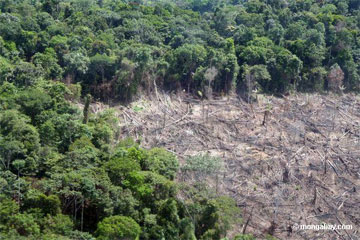Tropical deforestation is ‘one of the worst crises since we came out of our caves’
Tropical deforestation is ‘one of the worst crises since we came out of our caves’
Jeremy Hance, mongabay.com
May 15, 2008
|
|
Speaking at the Asia-Pacific Forestry Week in Vietnam, keynote speaker Dr. Norman Myers stated: “I’m going to give you my bottom-line message right now, up front, this is a super crisis that we are facing, it’s an appalling crisis, it’s one of the worst crises since we came out of our caves 10,000 years ago. I’m referring of course to elimination of tropical forests and of their millions of species.”
Dr. Myers continued, stating that when he first went to school “across the tropics there was a bright rich green band denoting tropical forests” on his atlas. “I put to you that we have lost half of all that green band and unless we start to do a far better job than we have been doing than by the time my children and so on, so on and my grandchildren are in school than they will have atlases than they will see not a bright green band across the tropics but the might have to color those atlases a dirty brown color to show that was once there has now disappeared. And what was once there, it says something super special, it is the most exuberant and colorful, and diverse expression of nature that has ever graced the face of this planet in many millions of years. That is what is at stake here.”
 Oil palm plantation abutting tropical rainforest.  Oil palm plantation and logged-over forest in Borneo. |
Dr. Norman Myers is a well-known and renowned British biologist. Currently, an Oxford professor, Myers has had a long history of pointing out large environmental issues before accepted by other scientists, such as the current mass extinction, the pace of tropical deforestation, and perverse subsidies which go against both the environment and the economy. Some of his books include The New Consumers: The Influence of Affluence on the Environment and The Sinking Ark: A New Look at the Problem of Disappearing Species.
In looking at the reasons for current deforestation, Myers pointed to four major contributors in his speech. According to his statistics, 5 percent of deforestation was due to cattle ranching, 19 percent to over-heavy logging, 22 percent to the growing sector of palm oil plantations, and 54 percent due to slash-and-burn-farming.
Myers stated that the percentage due to cattle ranching was the one bright spot, since it used to be a much larger driver of deforestation. While Myers stated his approval of industrial logging in tropical forests, he warned that his approval only extended to those operations that are “done sustainably”. In regards to palm oil, Myers argued that he would like to see products which contain palm oil reflect the true cost of their production, i.e. taking into account the loss of forests in South East Asia.
 Deforestation in Madagascar. |
But the biggest shift in deforestation, according to Myers, was in slash-and-burn farming. Myers stated that slash-and-burn-farming used to be undertaken by the “shifting cultivator”. These cultivators would deforest small areas for subsistence farming and then move on when the soil’s richness gave out in a few years. Myers called such slash-and-burn farming a “form of exploitation of tropical forest that has been entirely sustainable”. For one thing, worldwide, shifting cultivators were numbered at 30 million. But now, Myers said that we are seeing what he calls the “shifted cultivator”. They are “the displaced peasant, who finds himself, let’s say in southern Brazil, who finds himself landless, jobless, no prospect of getting on, getting supper on the table, so he feels in his desperation he picks up a machete, a matchbox and heads off to Amazonia where he torches the forest.” There are an estimated 300 million shifted cultivators worldwide, leading to deforestation on a massive scale, which cuts deeper into the forest and does not allow once-exploited forest to regenerate.
Although Myers recognized that a lot had been done in conservation of tropical forests, he acknowledged that none of efforts had slowed the tide of tropical destruction. “Despite all the money that we put into tropical forestry, and all the science and technology we put into it, and all the public attention we have had, and all the government emphasis that we’ve had, things have nevertheless been getting worse and worse year by year, and I further believe that if we continue to operate within our present policy framework that even if we had five times as much amount of money, and five times as much scientific understanding, and so on and so on, that we would still find things going down the tubes.”
Despite the overwhelming nature of the crisis, Myers still has hope: “We still have time, just enough time, to save the remaining forests and all their species.”
The conference where Myers spoke was put on by the UN’s Food and Agriculture Organization (FAO). The April conference had an estimated 600 participants from over 50 countries, including forestry officials from 33 regional nations.

Deforestation in Peru |
According to Patrick Durst, a senior forestry officer with FAO, the week covered numerous topics: climate change, indigenous people, invasive species, poverty alleviation through forests, the REDD program, illegal logging and trade, forest markets, and forestry research. In an interview on the FAO website, Durst sees “more and more desire to link the global forestry dialogue with regional mechanisms and the action that’s happening in the regions, and so we are looking forward to Forestry Week taking an important step forward to that, people working in the region, working on the ground, have a lot of practical experience that we want to feed into the global dialogue”.